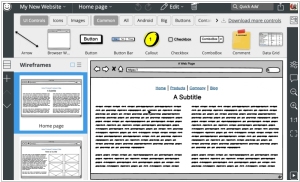Balsamiq vs Figma
March 10, 2025 | Author: Sandeep Sharma
11★
Balsamiq really shines during the early stages of designing a new interface. It offers the same speed and rough feel as sketching with pencil, with the advantage of the digital medium: drag & drop to resize and rearrange elements, make changes without starting over, and your work is clear enough that you'll make sense of them later.
28★
The collaborative interface design tool. Each contributor owns their part of the creative process and stays in sync along the way - across any platform. Securely connect teams, fonts, and libraries across your entire company.
Balsamiq and Figma are both tools for creating digital designs, which is a fancy way of saying they help people draw boxes and buttons on screens. They let multiple people poke at the same design at the same time, which is either a brilliant leap for teamwork or a recipe for pixel-based chaos. They come with handy libraries full of pre-made elements so that you don’t have to reinvent the checkbox every time you need one. Both live in the cloud, which sounds mystical but really just means they work in a browser and occasionally lose your work when the Wi-Fi sneezes. Also, they both allow real-time editing, which is like trying to paint a masterpiece while someone else keeps adjusting your brush.
Balsamiq, however, has chosen to embrace the fine art of looking like a badly drawn napkin sketch. This is intentional. The idea is that if your wireframes look rough, nobody will assume the design is final and start complaining about the shade of gray in a button. It’s been doing this noble work since 2008, making it a wise elder in software years. Born in the United States, it caters to product managers, business folks and anyone who likes to say “Let’s just get the basic structure down first” before promptly redesigning everything two days later. It does not concern itself with fancy animations or interactive flourishes. It is simple. It is quick. It is, in a way, the aesthetic embodiment of giving up on perfection before you even start.
Figma, on the other hand, is sleek, sharp and terrifyingly competent. It’s vector-based, which means everything is crisp, scalable and impossible to draw freehand unless you enjoy paths snapping to places you didn’t intend. Founded in 2016 (also in the U.S.), it is built for designers, developers and people who enjoy debating the philosophical implications of padding versus margins. It is cloud-based, collaborative and packed with plugins, because why do one thing well when you can do a thousand? Unlike Balsamiq, Figma fully expects you to make something polished, refined and slightly intimidating, complete with animations that suggest you know exactly what you’re doing.
See also: Top 10 Online Design software
Balsamiq, however, has chosen to embrace the fine art of looking like a badly drawn napkin sketch. This is intentional. The idea is that if your wireframes look rough, nobody will assume the design is final and start complaining about the shade of gray in a button. It’s been doing this noble work since 2008, making it a wise elder in software years. Born in the United States, it caters to product managers, business folks and anyone who likes to say “Let’s just get the basic structure down first” before promptly redesigning everything two days later. It does not concern itself with fancy animations or interactive flourishes. It is simple. It is quick. It is, in a way, the aesthetic embodiment of giving up on perfection before you even start.
Figma, on the other hand, is sleek, sharp and terrifyingly competent. It’s vector-based, which means everything is crisp, scalable and impossible to draw freehand unless you enjoy paths snapping to places you didn’t intend. Founded in 2016 (also in the U.S.), it is built for designers, developers and people who enjoy debating the philosophical implications of padding versus margins. It is cloud-based, collaborative and packed with plugins, because why do one thing well when you can do a thousand? Unlike Balsamiq, Figma fully expects you to make something polished, refined and slightly intimidating, complete with animations that suggest you know exactly what you’re doing.
See also: Top 10 Online Design software




